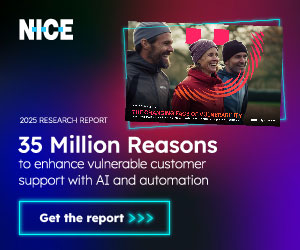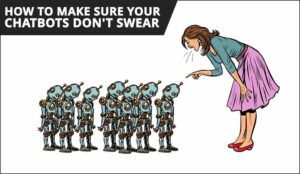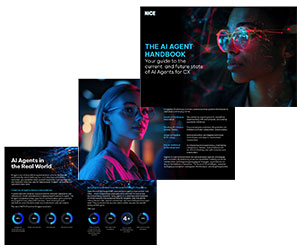Gartner predicts that 85% of customer interactions will be managed without humans in 2021. This might be a scary notion for agents who are sensitive to job security, but rest assured that human agent jobs aren’t going away.
Why? The contact centre is still inherently a forum for human engagement. The 85% of interactions that can be offloaded from human agents will be represented by the pesky repeat issues and questions that customers have that can sap an agent’s productivity.
Imagine the additional productivity you can get from agents if they aren’t chasing down account balances or processing payments. The reality is, bots and virtual agents will be a complement to their human counterparts, not a replacement.
Bots and virtual agents will be helping their human teammates versus taking jobs from them. Chatbots and virtual agents have both become important spokes on the CX wheel – and that wheel will remain anchored by human agents.
Used correctly, bots can become an agent’s best friend, helping them achieve and exceed personal agent KPIs while helping lift the operational performance KPIs, CSAT, and NPS that contact centre leaders and agents live by.
What Do Customers Think of Bots?
The answer to this question is that consumers want bots BUT (there’s always a but) there is a twist. Consumers were asked their opinions on using bots and other tech that enable them to solve issues on their own.
While 84% of consumers say they are more willing to do business with a company that offers self-service options, only 61% say that companies make self-service easier. In fact, when rating self-service channels only ONE THIRD are highly satisfied.
In other words, businesses have work to do in creating a satisfying, enriching self-service experience for customers.
The first step is opening those self-service channels and give consumers the ability to solve issues themselves if they choose not to speak to an agent. When it comes to chatbots and/or virtual agents there are a few best practices to consider:
Know what problem you want the bot to solve. Don’t overtask a bot to handle too many things. Rather, create individual bots that each have an area of expertise.
Bots are only as good as the information they contain, putting too much information in a single bot – or – asking a single bot to resolve one too many use cases will confuse it.
Why? Because bots are taught to recognize keywords or key phrases. Multiple use cases for a single bot may carry overlapping keywords, which will cause the bot to misinterpret the issue that the customer wants to resolve.
That leads to an eye-roll and then a “can I just speak to a person please” mentality that leaves agents at a disadvantage.
When the customer does connect with an agent, not only will they be frustrated but because they abandoned the session with the bot, the agent will also not have the advantage of viewing data collected from the bot to provide personalized service.
This issue happening at scale can and will impact CSAT, NPS, and FCR among others, leaving YOU thinking “I made a bad investment.” You didn’t, you just made an error.
Bots are a workforce! Implementing chatbots or virtual agents is not a set it and forget it exercise.
While virtual agents have the advantage of machine to machine learning, leveraging things like Natural Language Processing (NLP) and Natural Language Understanding (NLU), chatbots are a simpler being – both have a place on the CX wheel of spokes.
For bots, ensuring that information is kept up to date (this may mean new products, promotions, processes, etc) is an absolute imperative. Depending on the velocity of change in your products and services, you may want a dedicated resource monitoring your bot and making updates.
ALWAYS ALWAYS ALWAYS have an escalation path to a live agent at any phase of the engagement with a chatbot.
As a consumer, when presented with an “I can solve this myself” option – a personal preference is to use that option if the reason for the engagement is simple enough to not require a human engagement.
Once you commit to that, though, it becomes incredibly frustrating if you are unable to resolve the issue yourself and you simply have to pick up the phone and call.
Again, this doesn’t do your human agents any favours because the data that had been collected by the bot is not going to be presented to the agent.
Making sure that the option to connect to a live agent in every stage of engagement with the bot goes a long way in keeping data intact, agents informed and customers generally pleased with the self-service options.
Bots, Automation, and Contact Centre Results
It’s no secret that contact centre leaders are looking for ways to accommodate increases in volumes. AI in its various forms in the contact centre are tools to accommodate that, and guess what? They are good tools.
Whether you are leveraging a bot or a virtual agent to help manage volumes and take routine issues off the shoulders of your human agents or leveraging AI-driven workforce management to help contact centre leaders accurately forecast and easily schedule, the bottom line is that AI does two things, it reins in the chaos and helps contact centres achieve their goals, and it allows customers to help themselves and ultimately drives stronger connections, greater opportunities for repeat business and stronger customer loyalty.
Leveraging technology like AI that helps customers help themselves improves CSAT, NPS, and FCR. Bots and other self-service options give agents time back in the day to focus on both helping customers with more complex issues and on learning and development, upping their game and helping contact centres meet their targets, oftentimes exceeding them.
AI Is Taking a Front Seat in Coaching
As noted above with bots, know what problem you are trying to solve for and align the right AI-powered tech to support it. Looking to give contact centre managers greater insight into operational performance? AI-powered analytics is a good place to start.
Everything we’ve talked about with AI so far in terms of agent productivity and performance has revolved around giving agents back time in the day to either learn or to handle more complex issues that require human engagement.
BUT – AI is also becoming an incredible tool for coaching agents in the moment, while they are on calls. Real-time Interaction Guidance delivers AI-powered insights to agents as calls are occurring – advising them on when they need to be actively listening, not interrupting, and taking ownership (among a long list of other behaviours.)
This helps guide calls as they are happening, providing actionable coaching to agents so that they can course-correct in the moment, versus receiving feedback after the fact in a coaching session with a contact centre leader.
Real-time Interaction Guidance represents quantum leaps in the application of AI in the contact centre. Where algorithms essentially listen to the call as it’s ongoing and pop conversation bubbles (unobtrusively) to the agent to ensure that they are giving the optimal response.
The result, at scale, is impressive – allowing contact centre leaders to gain control over something that has until now had to be done after a call when a customer may have left the engagement frustrated.
AI Helps Deliver Knowledge
AI’s capabilities don’t end there. AI and machine-to-machine learning is also helping agents access information with incredible speed and accuracy as well.
Imagine that while an agent is engaged in a discussion with a customer, and the customer asks about a product or a specific process or policy, that the agent doesn’t need to go looking for it across disparate, disconnected information silos and systems.
Rather, the piece of information the customer is asking about appears on their screen (just like the real-time coaching). AI-driven knowledge bases are making enormous differences in delivering speedy resolutions to customers and are another example of how human agents and their ‘robot’ counterparts work together to deliver exceptional CX.
Back to Bots
Know what’s on your bench. Data analysts understand the architecture and analytics – what’s more, they can support integrating disparate data, structure or categorize data, support workflow and intent mapping.
Assess your previous interactions and documented processes. Knowing those two elements will help you understand whether you can insource the development of your bot or whether to go to a Managed Services Provider or Systems Integrator to help you build your bots and virtual agents through an outsourced model.
Bots and AI are not the enemy of the agent, they will help them emerge as stronger, more capable stewards of the brand experience and more reliable and trusted advocates for your customers.
Next, if you are considering bots and virtual agents, it means you are also considering AI – don’t turn a blind eye to what other functions AI can help accelerate and improve in the contact centre – things like workforce management (WFM) offer contact centre leaders a far superior means of forecasting and scheduling than the old tried and true method of poring over spreadsheets and losing sleep at night.
Additionally, consider what AI can do to help your agents in the moment with AI-powered interaction guidance and intelligent knowledge bases, both of which can put critical information on the agent’s screen without them having to hunt for info or wait for a post-mortem coaching with their supervisor.
This blog post has been re-published by kind permission of NICE CXone – View the Original Article
For more information about NICE CXone - visit the NICE CXone Website
Call Centre Helper is not responsible for the content of these guest blog posts. The opinions expressed in this article are those of the author, and do not necessarily reflect those of Call Centre Helper.
Author: NICE CXone
Published On: 17th May 2021 - Last modified: 18th May 2021
Read more about - Guest Blogs, NICE CXone






 NICE CXone combines best-in-class Omnichannel Routing, Workforce Engagement, Analytics, Automation and Artificial Intelligence on an Open Cloud Foundation.
NICE CXone combines best-in-class Omnichannel Routing, Workforce Engagement, Analytics, Automation and Artificial Intelligence on an Open Cloud Foundation. 










